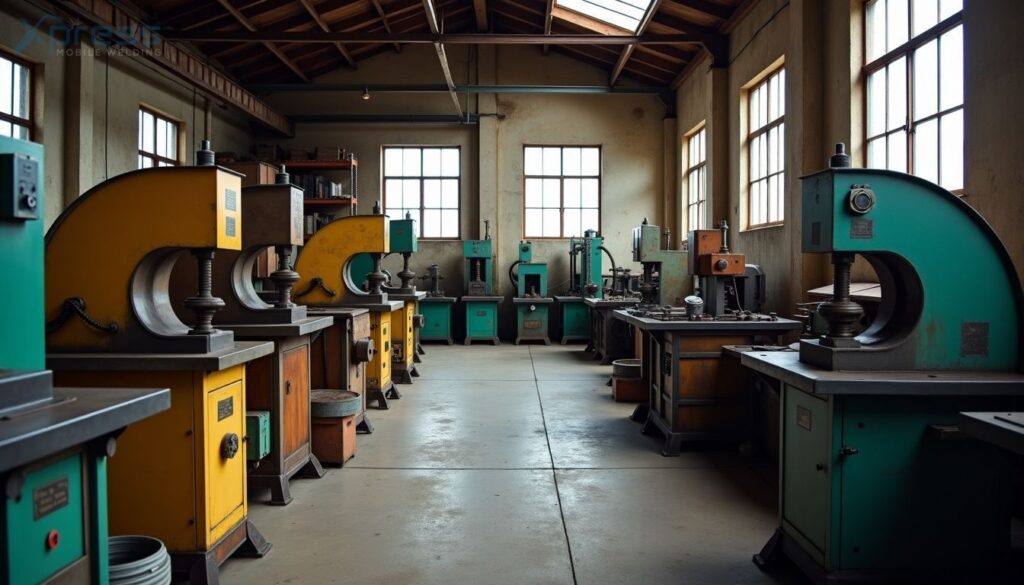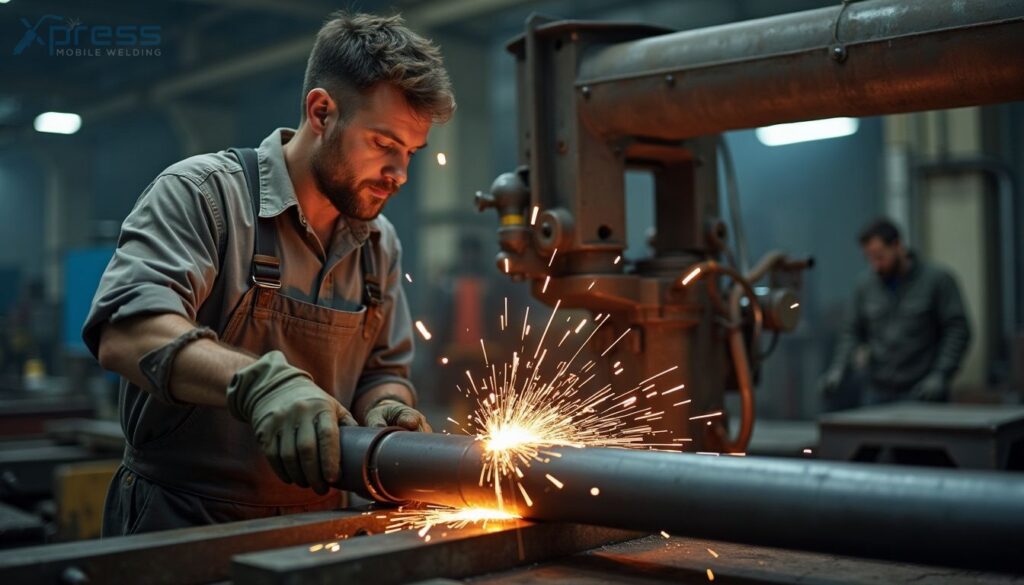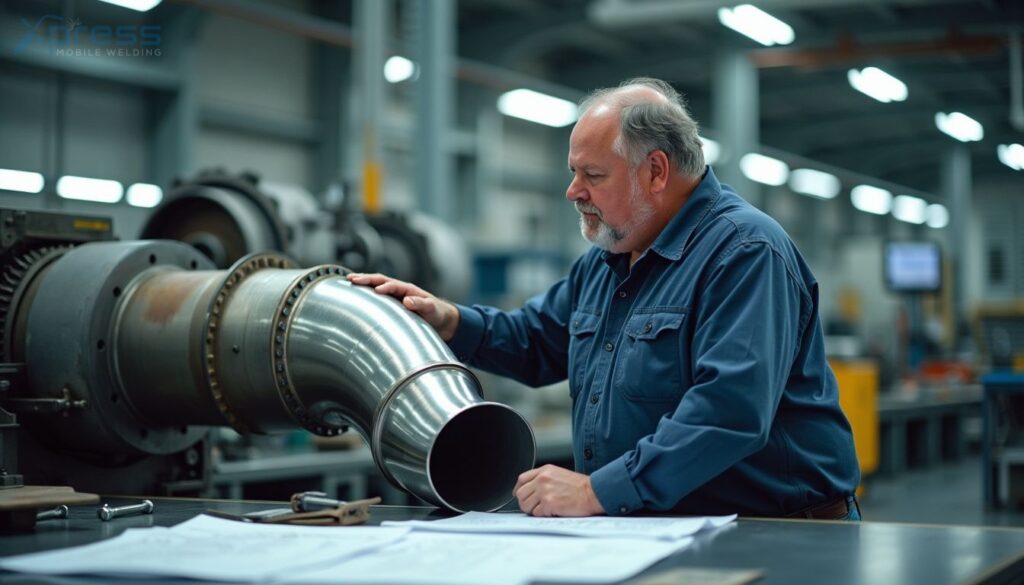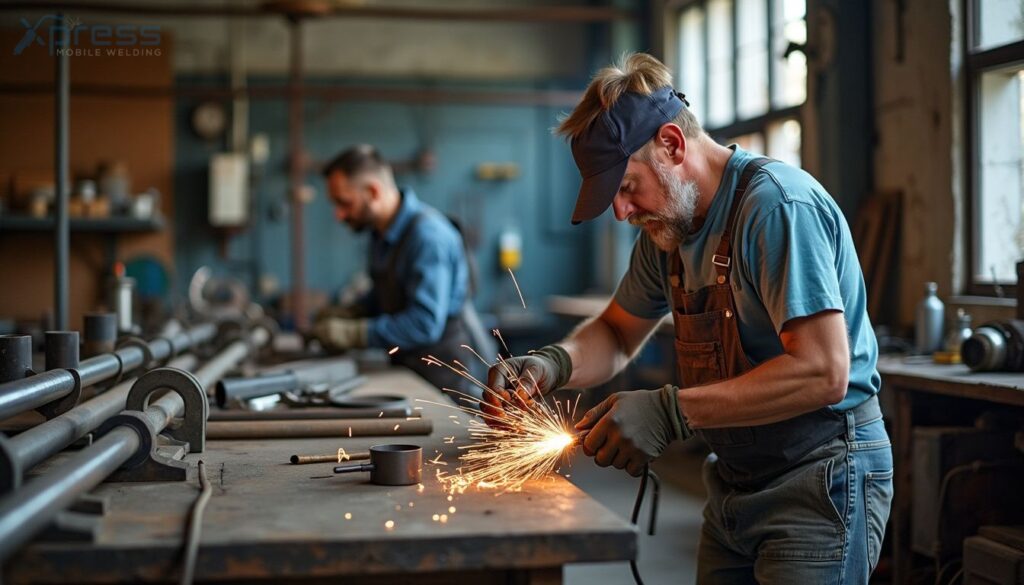Struggling to achieve precise bends in metal? Tube and pipe bending welding is key. This article will guide you through expert techniques for exact results. Read on for secrets in metalworking.
Key Takeaways
- There are different ways to bend tubes and pipes, like ram-type bending, roll bending, compression bending, and rotary draw bending. Each way has its own use depending on what you need.
- Tools like dies and mandrels help make bends clean without ruining the shape. Lubrication keeps the metal smooth as it bends.
- The material of the pipe or tube matters a lot in how well it can bend. Things like how thick it is and what it’s made from affect the process. Aluminum, steel, copper, and stainless steel are common materials for bending.
- Machines that bend pipes can be very advanced. They use technology to make precise bends in many directions at once.
- Bending pipes is important for making things like car exhausts, building frames, and parts for airplanes. Each project needs careful planning around the type of metal used and how much it needs to bend.
Key Processes in Tube and Pipe Bending

Tube and pipe bending involves several key processes, each serving a specific purpose. These include ram-type bending, roll bending, compression bending, and rotary draw bending. Each method has its unique advantages in achieving precise bends for different tubing and piping applications.
Ram-type bending is a simple method where a hydraulic ram pushes the metal pipe or tube against rollers. This process forms the bend by driving the pipe into a form. It’s common in muffler shops.
The technique usually results in a centerline radius (CLR) three to four times the outside diameter (OD) of the workpiece.
Ram-type bending shapes pipes and tubes with pressure and force.
Roll bending uses three rollers set in a pyramid shape. This method shapes big pieces for construction. The machine pushes the metal between the rollers. As it moves, it slowly bends to the wanted shape.
This process works well for large, long items like beams or pipes.
This technique is sure to give smooth curves on thick materials. It can handle different sizes and types of metals, including steel and aluminum. Roll bending makes strong curves without weakening the metal.
It’s perfect for building frames and structures that need to be both tough and good-looking.
Compression Bending
Moving from roll bending, compression bending is another key technique. This method uses a roller or a die to shape the tube around a fixed bend die. It works best for making parts that look the same on both sides.
The process makes sure the bends are even and clean without changing the tube’s roundness too much.
Compression bending suits symmetrical pieces well. Because it keeps the workpiece in place while shaping it, this approach ensures accurate and repeated results. This makes it perfect for jobs needing many identical bends.
Rotary Draw Bending
Shifting from compression bending, we move to rotary draw bending. This method shines for making tight bends. It uses dies and mandrels to shape tubes without flattening or wrinkling them.
The tube wraps around a form, keeping its round shape and avoiding thinning on the sides.
Rotary draw bending ensures precision in each curve.
This process works well with different materials like stainless steel and aluminum. It suits tasks needing small bends. Plus, it helps when the tube’s wall thickness varies. Tools like wiper dies keep the tube’s interior smooth during bending, adding quality to the bend’s finish.
Essential Tools and Equipment for Bending

To achieve accurate pipe and tube bend results, it’s vital to utilize specialized tools and equipment designed for bending purposes. These consist of dies and mandrels, lubrication elements, and bending machines.
For additional details on these pivotal tools and equipment for bending, please continue reading.
Dies and Mandrels
Dies and mandrels are key tools in the tube bending process. Dies help shape the tube by pressing it into a specific curve. They often have a center-line radius (CLR) marked on them.
This CLR is important for achieving the right bend in the pipe or tube. However, the actual bend will be slightly bigger because of springback, where the metal tries to return to its original shape.
Mandrels go inside the tube during bending to support its shape and prevent wrinkling or collapsing. They are crucial for keeping the inner wall smooth and preventing defects when bending pipes with thin walls or tight radii.
By using mandrels, workers can ensure that tubes meet exact specifications for all sorts of projects, from car exhausts to aerospace components.
Lubrication Factors
Lubrication is key in tube and pipe bending. It helps the tools slide easier and protects the metal. Think of it like using soap to help your hands glide across each other smoothly.
For different metals, like copper or aluminum, you need specific lubes. This makes sure the bend is clean without any damage.
The right lubricant makes all the difference in bending pipes and tubes efficiently.
Using less lube can cause more friction. This means more force is needed to bend the tube or pipe. Too much force without enough lubrication can wreck both the tool and the metal piece.
So, we always use enough lube to keep everything moving smoothly without any trouble.
Bending machines play a big role in metalworking. They press or shape tubes and pipes to make bends. Some use dies and mandrels to stop the tube from flattening. The most advanced bending machines can handle many kinds of bends in one go.
They have up to ten axes for control, like Y, B, C, X, Z, XR, XC, YB, YM, YSFO. This means they can bend pipes very precisely.
These machines are key for making parts in cars and planes where shapes must be perfect. They help make exhaust systems in cars and parts for aerospace that fit just right. Using CNC technology lets operators set exactly how the pipe should bend.
This removes guesswork and makes sure each bend is the same as the last one.
Material Considerations for Bending

When choosing materials for bending pipes and tubes, factors such as the type of material, its thickness, and the center line radius need to be carefully considered. The material’s ability to withstand the bending process should also be taken into account in order to achieve precise bend results.
Tubing and Piping Materials
Choosing the right materials for pipe and tube bending is key. Aluminum, stainless steel, steel, and copper are common choices. Each material behaves differently during bending. Copper expands less than steel, and steel springs back less than stainless steel.
Wall thickness also matters a lot. Pipes with thicker walls are stronger but harder to bend. The center line radius (CLR) tells us how sharp a bend can be. Materials must match the project needs to get good results without breaking or warping the pipes.
Wall thickness affects how a pipe or tube can bend. Thicker walls handle more pressure but might slow down flow inside. They are stronger, so they bend without breaking. Thin walls are easier to bend, but they could collapse under pressure.
We use specific tolerances to make sure the wall thickness is just right for bending and strength.
Next, we look at the center line radius (CLR). It’s key in deciding how sharply a pipe or tube can bend.
Center Line Radius (CLR)
The Center Line Radius (CLR) is a critical factor in tube and pipe bending. It should be 2-3 times the diameter of the tube. Tighter bends necessitate more complex tooling to achieve accurate results, making CLR an essential consideration in bending processes.
Considering that the CLR should be 2-3 times the tube’s diameter, this measurement is crucial for achieving precise and accurate bends. Tighter bends require more intricate tooling, emphasizing the importance of paying attention to CLR when performing tube and pipe bending operations.
Practical Applications of Tube and Pipe Bending

Tube and pipe bending has diverse practical applications. It finds use in automotive exhaust systems, architectural structures, and aerospace components. Each of these areas relies on precise tube and pipe bending to achieve specific design and functional requirements.
Automotive Exhaust Systems
The process of pipe and tube bending is widely used in the manufacturing of automotive exhaust systems. Ram-type bending, a common method used in muffler shops, and rotary draw bending are essential techniques for creating precise bends required for exhaust pipes.
The CLR (center line radius) in these applications typically ranges from three to four times the diameter of the workpiece, ensuring optimal performance and fit within the vehicle’s design.
In addition, materials such as steel and aluminum are frequently employed due to their durability and heat-resistant properties, which are crucial for withstanding high temperatures generated by automobile engines.
Numerous factors must be carefully considered when crafting an automotive exhaust system through pipe and tube bending processes. These include wall thicknesses of pipe or tubing materials, exterior diameters, material compositions such as brass or aluminum, maintaining consistent clamping pressure during the bending process using hydraulic rams or immobile rollers against pivot blocks to create bends that offer reliable functionality at tighter radii without compromising structural integrity.
Architectural Structures
Architectural structures often utilize tube and pipe bending for various applications. This process is particularly common in creating handrails, staircases, and building frameworks.
By employing roll bending techniques, large workpieces essential for construction projects can be accurately shaped to meet architectural design requirements.
In designing architectural structures such as buildings and bridges, tube and pipe bending are crucial processes. Roll bending, which involves three rolls in a pyramid configuration, is commonly utilized to efficiently shape materials for these monumental creations.
The precise nature of tube and pipe bending ensures that the resulting structures meet engineering tolerances while maintaining the required strength and durability.
Aerospace Components
Aerospace components often require precise and complex tube and pipe bending due to the critical nature of these parts. These applications may involve tight radii, which can be achieved through rotary draw bending, a dominant method in creating accurate bends.
The aerospace industry extensively utilizes these techniques for fabricating essential components such as fuel systems, hydraulic lines, and structural elements because they demand precision in design that ensures safety and performance.
Furthermore, aerospace engineers rely on materials with exceptional strength-to-weight ratios to meet stringent performance requirements while keeping weight at a minimum. This calls for thorough consideration of tubing materials, wall thicknesses, and bend radii to achieve the necessary structural integrity without compromising weight limitations.
For instance, aluminum is commonly used due to its lightweight properties while maintaining high strength. Aerospace application examples involving tube and pipe bending include aircraft exhaust systems or fluid conveyance within the aircraft’s infrastructure.
Conclusion
In conclusion, mastering tube and pipe bending techniques requires understanding the critical variables of material, machine, tooling, and lubrication. The precision of welding is crucial to avoid negative impacts on bending results.
This article has outlined four primary methods for bending tubes: ram-type bending, roll bending, compression bending, and rotary draw bending. It emphasizes the importance of proper lubrication using nonpetroleum-based synthetic lubricants.
Understanding the differences between metal pipes and tubes is essential in achieving precise bends. Overall, this comprehensive guide serves as a valuable resource for those seeking expertise in tube and pipe bending welding techniques.
Quality Mobile Welding Services Available Near You
Enhance your welding skills with Xpress Mobile Welding in Mesa, AZ! We provide expert, tailored stick welding training right at your location. Our hands-on approach ensures you gain confidence and proficiency in your technique. Contact us now to begin your journey and elevate your welding expertise today!

